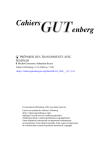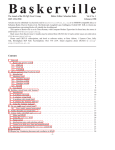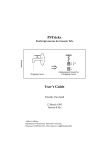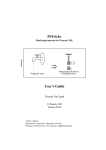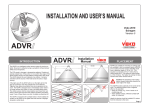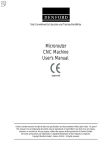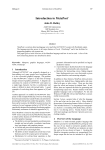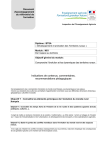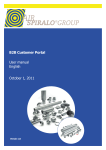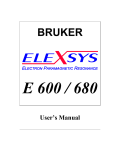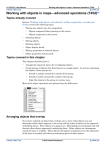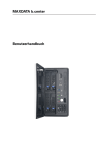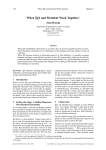Download Colour slides with LATEX and seminar.sty
Transcript
Colour slides with LATEX and seminar.sty
Bijlage S
63
Colour slides with LATEX and seminar.sty 1
Michel Goossens
(CERN)
Sebastian Rahtz
(ArchaeoInformatica)
Slides and LATEX
1
Many LATEX users want to take advantage of TEX’s highquality typesetting when they produce overhead slides for
a presentation. This facility was originally provided by a
separate package, SLITEX, but that had a number of disadvantages:
it was limited to a set of specially-scaled Computer
Modern fonts and it was not easy to adapt to other
fonts;
the user was required to have two separate files, one for
control information and the other for the actual slides;
the control of colour and overlays was limited and
crude;
There was only one ‘style’ for slides, and writing a different layout (to, say, put a logo on each slide) was not
documented.
LATEX users now have a variety of fonts, and vast numbers of styles, to choose from, but SLITEX has lagged behind. When LATEX2" was released at the end of 1993,
this included a simple LATEX package (already available
in the New Font Selection Scheme, version 2) to emulate
SLITEX without the overhead of a separate macro package.
However, there is a much better LATEX package which has
been available for some time now—seminar.sty; if used in
conjunction with a POSTSCRIPT printer, and a set of useful
macros called PStricks,2 this offers almost every imaginable facility, including:
☞ Fancy frames, headers and footers;
☞ Landscape and portrait slides in the same document;
☞ Coloured text and tables;
☞ Interleaving of annotations and slides;
☞ Slide ‘chapters’ and list of slides;
☞ Overlays.
seminar is a normal LATEX package which can be used
with almost all other LATEX packages (such as those to
change font, include graphics etc). Its main job is to produce transparencies, but it can also make accompanying
notes from the same file. It is compatible with
LATEX and LATEX2" .
2
AMS -
Using the seminar style
Usage is simple; begin your document in the normal way3
with
\documentclass{seminar}
or
\documentstyle[... options ...]{seminar}
The slide environments are
\begin{slide}
...
\end{slide}
\begin{slide*}
...
\end{slide*}
Where slide is for landscape slides and slide* is for
portrait slides. By default, the document is typeset in landscape mode, but if you include the portrait style option,
the document is typeset in portrait mode. Typesetting the
document in landscape mode is different from printing it in
landscape mode; you have to worry about the orientation
of the page when printing, but with dvips this is simple,
and taken care of in the local control file described below.
So the default output4 from this input:
\documentclass{seminar}
\usepackage{times}
\begin{document}
\begin{slide}
My talk is about:
\begin{description}
\item[Cats] Nice furry creatures
which should have a place in
every good home;
\item[Dogs] Nasty barking things
which bite you;
1
Reprint from the Annals of the UK TEX Users’ Group: Baskerville, Volume 4.1, Januari 1994.
The seminar package and PStricks are the work of Timothy van Zandt ([email protected]).
3 We are assuming LAT X2 here, just to remind you to upgrade.
E "
4
We have added a style option output ‘times’ so that the output will reduce properly to thumbnails for this article.
2
Dutch TEX Users Group (NTG), P.O. Box 394, 1740 AJ Schagen, The Netherlands
Preprint MAPS#12 (94.1); May 1994
Colour slides with LATEX and seminar.sty
64
\item[Snakes] They come slithering
through the grass and \emph{have
no feet}; this is most
disturbing;
\item[Rhinoceroses]
\textbf{Never} be rude to a
rhino; they are bigger than you,
and meaner.
\end{description}
\end{slide}
\end{document}
Bijlage S
On the fifth day of Christmas, my true love gave
to me:
1. Five overfull hboxes
2. Four fontdimens missing
double
3. Three nested endgroups
4. Two undefined commands
5. . . . and a token in TEX’s stomach
1
'
$
On the fifth day of Christmas, my true love gave
to me:
1. Five overfull hboxes
My talk is about:
Cats Nice furry creatures which should have a place in every good
home
will look like:
2. Four fontdimens missing
oval
Dogs Nasty barking things which bite you;
3. Three nested endgroups
Snakes They come slithering through the grass and have no feet; this
is most disturbing;
4. Two undefined commands
Rhinoceroses Never be rude to a rhino; they are bigger than you, and
meaner.
5. . . . and a token in TEX’s stomach
&
%
1
1
Most slides will be no more complicated than this, using
standard LATEX environments like itemize, enumerate
and tabular.
3
Similarly, a variety of page styles (the headers and footers)
are available with the \pagestyle command, such as:
On the fifth day of Christmas, my true love gave
to me:
Frame styles
1. Five overfull hboxes
A variety of slide framing styles are available, set with
the \framestyle command; the following are some of
the predefined ones (some assume you have a POSTSCRIPT
printer), using the \slideframe command:
2. Four fontdimens missing
empty
3. Three nested endgroups
4. Two undefined commands
5. . . . and a token in TEX’s stomach
On the fifth day of Christmas, my true love gave
to me:
none
1. Five overfull hboxes
On the fifth day of Christmas, my true love gave
to me:
2. Four fontdimens missing
1. Five overfull hboxes
3. Three nested endgroups
4. Two undefined commands
2. Four fontdimens missing
plain
3. Three nested endgroups
4. Two undefined commands
5. . . . and a token in TEX’s stomach
5. . . . and a token in TEX’s stomach
1
1
On the fifth day of Christmas, my true love gave
to me:
shadow
1
+
1. Five overfull hboxes
On the fifth day of Christmas, my true love gave
to me:
2. Four fontdimens missing
1. Five overfull hboxes
3. Three nested endgroups
2. Four fontdimens missing
align
3. Three nested endgroups
4. Two undefined commands
4. Two undefined commands
5. . . . and a token in TEX’s stomach
1
5. . . . and a token in TEX’s stomach
+
+
Both slide frames and page styles can be customized; for
instance, the examples in this paper (eg Figure 1) are suitable for use at the European Particle Physics Laboratory
(CERN).
Preprint MAPS#12 (94.1); May 1994
Dutch TEX Users Group (NTG), P.O. Box 394, 1740 AJ Schagen, The Netherlands
Bijlage S
4
Colour slides with LATEX and seminar.sty
Interleaving notes, and selecting subsets
It is easy to intersperse your slides with notes to yourself;
these can be simply placed between the slide environments or enclosed in a specific note environment. You
can use any LATEX commands in these notes, and include
your whole article here if desired. When you want to print
the slides, a variety of style options can be used:
slidesonly Only the slides are printed;
notesonly Only the slides are printed;
notes The slides are interleaved with the notes;
article The document notes are typeset like a normal
LATEX paper, and the slides are placed as figures
(reduced to half size).
The \slideplacement command can be used to affect
how slides are placed in the \article format; the possible parameters are:
float (default) Slides are floated
float* Slides are floated, but if two column format is
chosen they will span both columns
here Slides are placed where they occur in the notes
Further detailed control of the interaction between slides
and notes is given in the User’s Manual.
Selected slides can be included or excluded with the
65
some fonts (especially for mathematics) are not available at
the size needed. If you use dvips, it tries to generate these
fonts but does not always find the necessary Metafont input files to successfully complete the generation of the new
font bitmaps. It makes sense, therefore, to use scaleable
POSTSCRIPT fonts; the complete Computer Modern family is available in POSTSCRIPT Type1 format, either in the
commercial set from Blue Sky or Y&Y, or in (slightly less
polished) public domain Paradissa set by Basil Malyshev.
7
The local control file
The seminar package always starts by trying to find a file
called seminar.con on the TEXINPUTS path; this gives the
user or site an opportunity to conveniently overwrite the
defaults. The seminar.con file can contain any LATEX
commands, including inputting style files. Figure 1 was
typeset using a seminar.con set up for CERN; the contents of this are given below, with explanation of what is
being done:
First, we set up landscape macros for the dvips driver.
\newcommand{\printlandscape}{%
\special{papersize=297mm,210mm}}
\onlyslides or \noteslides commands which a para-
meter of a comma-separated list of slides; this can be
numbers, ranges (e.g., 5–10) or LATEX \ref commands
referring to \label commands in the slides.
5
Control over slide size, fonts and magnification
There are a great number of parameters by which the user
can change any of the following either on a slide-by-slide
basis, or for the whole document:
Slide height and width;
Top, bottom, left and right margins;
Text justification (it is ragged right by default);
Page breaking by varying tolerance of over-running
material;
Inter-line spacing;
Point size, and choice of fonts.
How to change the default settings is explained in detail in
the User’s Guide.
Because seminar works by magnifying pages, sophisticated users should read the manual to see how to deal with
setting and changing TEX dimensions. Most users need not
worry about this—in commands like \epsfig you should
always express your ‘width’ and ‘height’ requests in fractions of the line size anyway.
6
We will assume POSTSCRIPT printers, and gain nice POSTSCRIPT effects like rounded box corners; these will need
some extra style files:
\input semcolor.sty
\input fancybox.sty
Since this setup is designed to be used in Europe, where
A4 paper is standard, we need to set up some sizes and
re-invoke the code to set internal parameters:
\def\paperwidth{210mm}
\def\paperheight{297mm}
\input sem-page.sty
\slidewidth 205mm
\slideheight 150mm
\def\slideleftmargin{.8in}
\def\sliderightmargin{.8in}
For slide ‘sections’, list of contents, etc we use another
style file:
\input slidesec.sty
Fonts
As the size of the text on your slides is larger than that for
normal text (articles, manuals, etc.), often you will find that
This gives us access to various internal commands, some
of which are used below. We can also produce a list of
slides, in two layouts:
Dutch TEX Users Group (NTG), P.O. Box 394, 1740 AJ Schagen, The Netherlands
Preprint MAPS#12 (94.1); May 1994
Colour slides with LATEX and seminar.sty
66
\listofslides
\Slidecontents
2
Frame styles
Introduction
3 Slides and LATEX
4 Introducing ‘seminar’
5 Normal slide with coloured background
and text
Frame styles
√
• Frame styles . . . . . . . .
Frame styles
3
4
5
6
Text colours and colour tables
6 Frame styles
⇒ • Text colors . . . . . . . . .
8
8 Text colors
• Colour tests . . . . . . . .
9
9 Colour tests
• A multi-page coloured table
10
Text colours and colour tables
Whereas the ‘cernsections’ style has section headings and
a logo:
• Z schemas built up with overlays . . . . . . . . . . . . 11
10 A multi-page coloured table
11 Z schemas built up with overlays
CERN
January 16, 1994
\newpagestyle{cern}%
{{\color{Black}\small
\textbf{+} \hfil \today
\hfil \textbf{+}}}%
{{\color{Black}\small
\textbf{+} \hfil \thepage
\hfil \textbf{+}}}%
7
Introduction
√
• Slides and LATEX . . . . . .
√
• Introducing ‘seminar’ . . .
√
• Normal slide with coloured
background and text . . . .
List of Slides
CERN
Introduction/2
January 16, 1994
Frame styles/2
For slide headings, there is a predefined \slideheading
command; we will amend this so that it is typeset with a
‘shadow’. A slidechapter command is also defined:
\newcount\@inchap
\@inchap0
\def\l@chapslide#1{%
\slide@undottedcline{#1}{}%
}
\def\slidechapter#1{%
\begin{slide}
\immediate\addtocontents{los}{%
\protect\l@chapslide{\ignorespaces%
\protect\bfseries
\protect\large #1}}%
\gdef\thechapterheading{#1}%
\end{slide}
\@inchap0
}
\newpagestyle{cernsections}%
{{\color{Black}\small
\raisebox{-.5cm}[0cm][0cm]{%
\epsfig{figure=cernlogo.eps,%
height=.8cm}}
\hfil\textbf{\theslideheading}
\hfil\textbf{\thepage}}}%
{{\small\color{Black}\today
\hfil\thechapterheading
/\inchap
}}%
For the slide frames, we define a frame with the word
‘CERN’ set in a coloured box on the lower left; this is
done using the PStricks macros (which are automatically
included by the ‘semcolor’ option above). The colour commands are also defined using PStricks (the code is not listed
here); the names are used in the ‘colour’ figure.
This allows the user to break the slides into groups; the
slide chapter title will be given in the bottom right corner
with this CERN style.
\def\@empty{}
\renewcommand{\makeslideheading}[1]{%
\gdef\theslideheading{#1}%
\def\@tempa{#1}%
\ifx\@tempa\@empty\else
\begin{Sbox}
\begin{Bcenter}
\large\textbf{#1}%
\end{Bcenter}
\end{Sbox}
\centerline{\shadowbox{\TheSbox}}
\vspace{1ex minus 1ex}
\fi
}
\newslideframe{cern}{{\SlideFront
\boxput(-0.7,-1.11){%
\psframebox[linecolor=black,%
fillcolor=ForestGreen,%
fillstyle=solid]{%
\hbox{%
{\normalsize
\sffamily
\color{Black}CERN}%
}}}{#1}%
\color{Black}
}}
Finally we make sure that each slide starts with the current
foreground colour.
\def\everyslide{\SlideFront}
\def\theslideheading{}
Now the CERN page and frame styles; the plain ‘cern’
style just places registration ‘+’ marks, and the date:
Preprint MAPS#12 (94.1); May 1994
Bijlage S
The user sets up slides with the command \SlideColours,
with two parameters, which are colour names for foreground and background. A synonym is defined for black
on white. We have to be a bit careful defining the frame
border, because by default it is coloured using the POSTSCRIPT ‘setgray’ operator, and that might not work with
colour separation, so we define an explicit blue frame (for
variety).
Dutch TEX Users Group (NTG), P.O. Box 394, 1740 AJ Schagen, The Netherlands
Colour slides with LATEX and seminar.sty
Bijlage S
1
67
Slides and LATEX
3
Colour slides with LATEX and seminar.sty
Slides and LATEX
Sebastian Rahtz
Many LATEX users want to take advantage of TEX’s high-quality
typesetting when they produce overhead slides for a presentation.
This facility was originally provided by a separate package, SLITEX,
but that had a number of disadvantages:
October 1993
• it was limited to a set of specially-scaled Computer Modern fonts
and it was not easy to adapt to other fonts;
• the user was required to have two separate files, one for control
information and the other for the actual slides;
• the control of colour and overlays was crude and limited;
The ‘seminar’ package and PStricks are the work of Timothy van Zandt
([email protected]), and the full source and documentation can be
obtained from CTAN archives.
• There was only one ‘style’ for slides, and writing a different
layout (to, say, put a logo on each slide) was not documented.
CERN
CERN
January 28, 1994
Introduction/1
\SlideColours{Yellow}{SkyBlue}
January 16, 1994
Introduction/3
\SlideColours{Black}{White}
Introducing ‘seminar’
4
Normal slide with coloured background and text
5
Normal slide with coloured background and text
Introducing ‘seminar’
The Urban Origins in Eastern Africa project:
There is a much better LATEX style file available now – seminar.sty; if
used in conjunction with a PostScript printer, and a set of useful
macros called PStricks, this offers almost every imaginable facility,
including:
1. Ran from 1987 to 1993, under the sponsorship of the Swedish
development agency, SAREC and the overall management of
Paul Sinclair at Uppsala.
• Fancy frames, headers and footers
2. To provide a framework of research and training for
archaeologists in the Comoros, Botswana, Kenya, Madagascar,
Mozambique, Namibia, Somalia, Tanzania, and Zimbabwe.
• Coloured text and tables
• Interleaving of annotations and slides
3. Interdisciplinary and international co-operation has resulted in a
dramatic increase in the range and scale of basic data from the
countries involved.
• Slide ‘chapters’ and list of slides
CERN
CERN
January 16, 1994
Introduction/4
\SlideColours{White}{Blue}
January 16, 1994
Introduction/5
Red on gradient White/JungleGreen
Figure 1: Colour in slide background and foreground: (simulated in black and white)
\newslideframe{blueframe}[%
\psset{linecolor=NavyBlue,%
linewidth=\slideframewidth,%
framesep=\slideframesep,%
cornersize=absolute,%
linearc=.5cm%
}]{\psframebox{#1}}
\def\SlideColours#1#2{%
\gdef\SlideFront{\color{#1}}%
\slideframe{\Framedefault}%
\slideframe*[\psset{fillcolor=#2,%
fillstyle=solid}]{blueframe}%
}
\def\blackandwhite{%
\SlideColours{Black}{White}%
}
The slide defaults will be for a detailed layout and CERN
logo, with yellow writing on a blue background:
\pagestyle{cernsections}
\slideframe{cern}
\def\Framedefault{cern}
\SlideColours{Yellow}{RoyalBlue}
The result of this setup is show in Figure 1; Figure 2 shows
how we might combine colour and seminar’s overlay com-
mands to highlight the relationship between parts of a program schema.
If you do not like the CERN layout we describe above
(or whatever your local system has provided), you can
‘roll your own’ to various degrees of sophistication. In
the simplest case you can just write a file in your local
directory:
% A do-nothing file seminar.con
\endinput
Of course it might be more sensible to build on our work
by redefining the commands so that they do what you want.
For instance, if you had the seminar.con described above,
and wanted to change the default set-up to black on white
and use a plain pagestyle and frame, you could add some
code in front of the command \begin{document}:
\documentstyle{seminar}
\pagestyle{plain}
\slideframe{plain}
\renewcommand{\SlideFront}%
{\color{Black}}
\begin{document}
\begin{slide}
...
Dutch TEX Users Group (NTG), P.O. Box 394, 1740 AJ Schagen, The Netherlands
Preprint MAPS#12 (94.1); May 1994
Colour slides with LATEX and seminar.sty
68
Z schemas built up with overlays
11
Z schemas built up with overlays
Bijlage S
11-a
Triangle
x, y, z : N
x>0
y>0
z>0
x+y>z
x+z> y
x+y+z> x
CERN
January 16, 1994
Text colours and colour tables/4
Z schemas built up with overlays
11-b
January 16, 1994
Text colours and colour tables/4
Z schemas built up with overlays
11-c
Equilateral
Triangle
#{x, y, z} = 1
Isosceles
Triangle
#{x, y, z} 6= 3
January 16, 1994
Text colours and colour tables/4
January 16, 1994
Text colours and colour tables/4
Figure 2: Slide overlays
If you still would like colour backgrounds for your slides
by keeping the ‘SlideColours’ interface, but with a plain
border and no CERN logos etc., you can use the following
set-up:
\documentstyle{seminar}
\pagestyle{plain}
\renewcommand{\SlideColours}[2]{%
\renewcommand{\SlideFront}{\color{#1}}%
\slideframe%
[\psset{fillcolor=#2,fillstyle=solid}]%
Preprint MAPS#12 (94.1); May 1994
{scplain}%
}
\begin{document}
\SlideColours{Red}{Yellow}
\begin{slide}
...
The complete syntax of the many other commands which
you have at your disposal is described in the seminar user
guide; you will probably also want to read the PStricks
manual!
Dutch TEX Users Group (NTG), P.O. Box 394, 1740 AJ Schagen, The Netherlands






